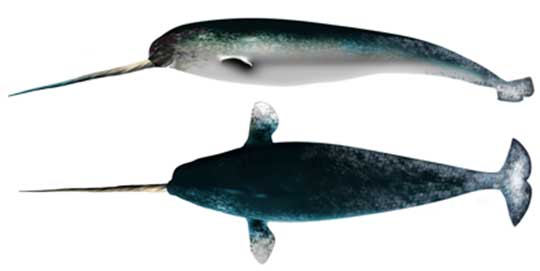About Narwhals
Narwhals are whales that live exclusively in Arctic and sub-Arctic waters. They feed primarily on halibut, cod, shrimp and squid. During the summer, they prefer feeding near coastlines, but during winter, they migrate away from shore, living beneath the ice-covered surface of the Arctic Ocean and surviving through sea ice leads and breathing holes in the ice.
The long spiral tusk that narwhals are known for is actually a single tooth that protrudes from their upper left jaw. Although narwhals are classified as toothed whales, they have no teeth in their mouth other than the tusk. Rare instances of double-tusked narwhals have been discovered, but males typically sport a single tusk; females rarely grow tusks. Adult male narwhals are up to 5 meters long (16 feet), not including their tusks, which can grow up to 3 meters (10 feet) long.
 This illustration shows top and side views of a male narwhal. The long tusk is in fact a tooth that protrudes from the upper left side of the male narwhal’s jaw.
This illustration shows top and side views of a male narwhal. The long tusk is in fact a tooth that protrudes from the upper left side of the male narwhal’s jaw.Unraveling the Tusk
The purpose of the narwhal’s tusk has stumped scientists for centuries. Scientists have long thought that the tusk was used for fighting, or as visual display of male dominance to attract females. Some researchers have also theorized that narwhals might use their tusk to break through sea ice or fend off other predators, such as polar bears and orca whales.
The tusk is not just an extension of tooth-like material. It is filled with sensitive pulp for nearly the entire length. Martin Nweeia’s investigations, in combination with Inuit observations and traditional knowledge, have revealed that the tusk may be a sensory organ. Narwhals may use their tusks to detect temperature, water pressure, particle gradients, and motion. In addition, the tusk is flexible, capable of flexing about 30 centimeters (1 foot) in all directions.
 Like teeth, narwhal tusks contain living pulp. This pulp forms a sensory organ through which the whale can sense a variety of environmental conditions.
Like teeth, narwhal tusks contain living pulp. This pulp forms a sensory organ through which the whale can sense a variety of environmental conditions.Because of the sensitivity to salinity concentrations in sea water, the male narwhal tusk may have the ability to read and navigate ice formation in Arctic waters. The whale’s migration and behavior patterns may thus be potential indicators of arctic climate and environmental change.

